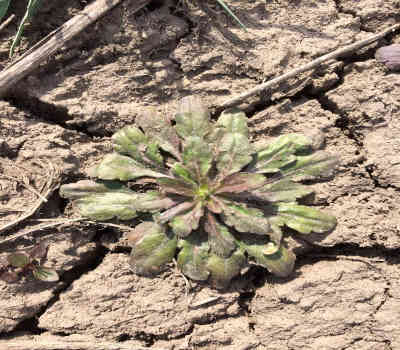By Meaghan Anderson & Bob Hartzler
After another relatively wet fall, late harvest season, and mild winter, early weed management may be important this spring for those who have persistent issues with winter annuals such as field pennycress and horseweed/marestail in no-till. Winter annuals resume growth soon after the arrival of warm temperatures, so as soon as fields are fit, the weeds will be susceptible to spray.

Applications made prior to planting increase the consistency of control of these weeds, particularly horseweed. Many of these weeds are either flowering or beginning to bolt, where the stems elongate, at the time of planting. Achieving full control of weeds at these stages becomes difficult.
Effective burndown treatments should follow herbicide label suggestions for carrier type, carrier volume, nozzle type, and environmental considerations. Treatments made on sunny days with warm daytime and nighttime (>40F) temperatures will generally be more successful than those in cooler conditions.
When selecting burndown treatments, consider the likelihood of resistant horseweed biotypes in the field. Herbicide group (HG)1 9 (glyphosate) and HG 2 (ALS) resistant populations are widespread across the state. Including 0.5 lb a.e. 2,4-D LVE, 0.25-0.5 lb a.e. dicamba (HG 4) or 1 oz Sharpen (HG 14) or another saflufenacil product to glyphosate will increase the consistency of horseweed control, even in fields without glyphosate resistance.
Check pesticide labels for planting restrictions; most 2,4-D labels have a 7-14 day planting restriction for corn or soybean following a 2,4-D application. Ester formulations of 2,4-D allow for a shorter interval to crop planting than amine formulations. In addition, esters often perform better under the cool conditions commonly encountered with spring applications. In dicamba resistant soybean, there is no planting restriction when using dicamba preplant, but only dicamba products registered for these varieties can be used. In non-dicamba resistant soybean, a 14-day planting interval is required at 0.25 lb a.e. and 28-day for 0.5 lb a.e. Any dicamba product describing this used can be used on non-dicamba resistant soybean.
The use of an effective early burndown against winter annual and early spring weeds is an important first step to achieving a clean field for crop planting. By including a product with residual activity, fields should remain weed-free and will allow for a delay in the next herbicide application until after crop planting. While this application is not necessary in many fields, those no-till fields with known winter annual weed issues may be good targets for an early burndown this spring.
The Group number refers to the site of action of a herbicide. The Group number is displayed on the first page of the herbicide label, and is important information for developing resilient weed management programs less likely to select resistant weeds.
Source : iastate.edu